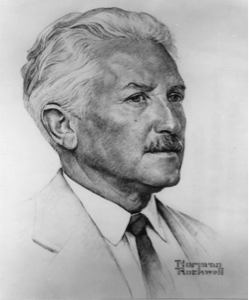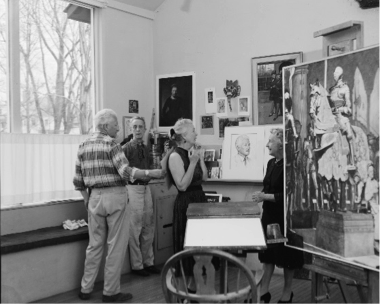INSPIRED: NORMAN ROCKWELL AND ERIK ERIKSON
June 8 through October 27, 2019
In February 1959, Norman Rockwell appeared on Edward R. Murrow’s celebrity interview show, Person to Person. For decades, Rockwell had painted wholesome scenes of American life, and Murrow interviewed Rockwell at his home in the bucolic small town of Stockbridge, Massachusetts. On the program, the artist described how much he and his family loved living in Stockbridge, never mentioning, of course, that they had made the town their home because it was also home to the Austen Riggs Center, a psychiatric institute where his wife, Mary, had been receiving treatment. Several years earlier, at a challenging time in his life, Rockwell himself had entered therapy at Riggs with Erik Erikson, a renowned developmental psychoanalyst who is perhaps best known for coining the phrase, “identity crisis.” The two men, both giants in their fields, became both confidants and friends, and as revealed in this exhibition, their far-reaching discussions fueled and influenced aspects of their work.
The development of identity was among Erikson’s greatest concerns, both personally and as a theorist. He maintained that, from infancy to childhood, personality is formed in a predetermined order through eight stages of psychosocial development, garnering varied outcomes dependent upon one’s experience. Highly regarded for this work, Erikson had not always been certain about his direction and vocation. In his youth, he considered the possibility of life as an artist, and traveled through Germany and Italy where he sold or traded artworks along the way.
Designed in collaboration with the Austen Riggs Center—a vital therapeutic community now in its 100th year—the exhibition will explore the relationship of the artist and the psychoanalyst, who fueled each other’s creativity in unique and important ways. Rockwell and Erikson’s artworks, rare photographs, personal correspondence, and video installations will be on view.
Learn more about the Austen Riggs Center’s Centennial exhibit at the Old Corner House here…
Norman Rockwell (1894-1978) Portrait of Erik Erikson, 1962. Charcoal on paper. Collection of Austen Riggs Center, Stockbridge, MA
Norman Rockwell and Mollie Rockwell with Erik and Joan Erikson in his Stockbridge Studio, 1962. Photograph. Norman Rockwell Museum Collection. ©Norman Rockwell Family Agency
ABOUT THE ARTIST
Born in New York City, Norman Rockwell always wanted to be an artist. At age 14, Rockwell enrolled in art classes at The New York School of Art (formerly The Chase School of Art). Two years later, in 1910, he left high school to study art at The National Academy of Design. He soon transferred to The Art Students League, where he studied with Thomas Fogarty and George Bridgman. Fogarty’s instruction in illustration prepared Rockwell for his first commercial commissions. From Bridgman, Rockwell learned the technical skills on which he relied throughout his long career.
Rockwell found success early. He painted his first commission of four Christmas cards before his sixteenth birthday. While still in his teens, he was hired as art director of Boys’ Life, the official publication of the Boy Scouts of America, and began a successful freelance career illustrating a variety of young people’s publications.
IMAGES
RELATED EVENTS
MEDIA
Art New England September/October, 2019 Inspired: Norman Rockwell and Erik Erikson
Art Geek June – October, 2019 Norman Rockwell and Erik Erikson
WAMC June 11, 2019 50 Years Of Illustration At Norman Rockwell Museum
The Berkshire Eagle May 31, 2019 Erikson and Rockwell: How their friendship helped shape the art
VENUE(S)
Norman Rockwell Museum, Stockbridge, MA June 8 through October 27, 2019




